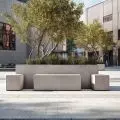Review from the04/22 issue of A&B
In 2009, RAM Publishing House (publisher of A&B until 2017) published Jan Gehl's book, translated from English by Marta A. Urbanska, "Life Between Buildings. The Use of Public Spaces." Although the publication was almost forty years old at the time, it actually became a revelation in Poland.
The debate about the quality of urban space, about the fact that well-designed streets, squares and plazas affect not only aesthetics, but most importantly the quality of life was then just beginning in Poland. Yes, EU money had already contributed to renovating city squares, building fountains, replacing floors in squares, but most of the activities were still centered around purely aesthetic issues.
The kind of thinking about the city that Gehl argued for was not widespread in Poland. There was little discussion of how human senses perceive space, the importance of designing for the speed at which users move, how tall they are, what they see and hear when they use urban space. That the direction of the benches and the distance between them is important, the light, the color, the background of the street, the width of the street matter. That all these elements make urban space not only better, more comfortable, prettier, but also safer and more functional for really all its users (so not just the young and fit). The Danish architect, of course, also paid attention to aesthetics, but he focused his research and projects primarily on functionality, on creating the city space so that it is good for its most important users - people on foot, including the elderly or small, with various disabilities, using wheelchairs. It was at Gehl's that one could read about paying attention to the so-called forecourts, which are valuable information about how people move. The most stylish, beautiful avenue will remain unused if it has an unintuitive, illogical course. It was Dane who showed how much information can be gleaned from falling snow - this one shows exceptionally well the scale and use of urban infrastructure, because in the snow you can see which way people really walk, drive cars or ride bicycles. The architect paid attention to how the direction of benches in a square or park works - it's not the aesthetics that matter, but what the person using such a bench will see. The volume "Life Between Buildings" contained dozens of similar insights, seemingly obvious, logical and banal, but for decades completely forgotten - both by urban planners, architects, officials, as well as residents and users of public spaces.
Jan Gehl's ideas on exploring and improving urban spaces have been appreciated in many places around the world. The architect has developed visions for the transformation of public areas, and has consulted and assisted in such projects in, according to his own words, more than two hundred and fifty cities around the world, from Denmark to the United States, from Great Britain to China, from Switzerland to Colombia and New Zealand. One can conclude from this that people are quite similar: regardless of culture or climate, there is a certain basic stock of solutions in public spaces that, with minor modifications, always make sense. After all, both in South America and Asia, people walk on two feet, like to talk to each other, look at storefronts, have something to sit on during urban wanderings, and just as much want to feel comfortable and safe in the city. Jan Gehl's name has been recognized around the world for decades, always associated with making cities better (only car fanatics who believe that the overriding value is the freedom to go everywhere in a private car perhaps have the opposite opinion - they don't like Gehl, because the architect takes this right away from them).
In 2021 the National Institute of Architecture and Urbanism published another book by the Dane, this time written in 2013 in collaboration with Birgitte Svarre. Also this publication was translated into Polish by Marta A. Urbanska. It differs slightly from the other two books Gehl published in Poland ( Cities for People was published in 2014 ). It is a kind of summary of almost half a century of the architect's experience, but also a historical look at various activities in urban space and theories concerning it. One would like to say that Gehl's latest publication is a kind of handbook on how to analyze public space and what tools to use if you want to get to know it better, but also to change it later. Importantly, it's a handbook written from the position of someone who himself is the author of most of the activities, projects, research and insights described. As Gehl and Svarre emphasize in the book's introduction:
Studies of life in public space are direct. Their basic premise is that observers go here and there, looking closely. Observation is the key, and its means turn out to be simple and cheap. Collecting observations into a system provides interesting information about the interaction of life in public space and that space itself.
And so the book's seven chapters are successive stages and ways of learning about city life, learning how to "read with understanding," how to observe, but also how to translate this information into practice and urban policy. The authors' insights are supported by examples, researched cases of various phenomena from the streets of cities in Europe, the United States,
Australia. As in a decent textbook, the text proper is supplemented with information that allows readers to understand the phenomenon of urban space and its formation more broadly. This is served by notes on important figures for the knowledge of urban space (including Christopher Alexander, Jane Jacobs, Peter Bosselmann), valued readings, but also iconic from the point of view of the development of urban space. One chapter of the book is a collection of notes entitled. "How They Did It," short analyses of specific places, such as a study of the Piazza del Popolo in Ascoli Piceno in terms of where in that city's space people are most likely to stop, stand, waiting for someone; in Copenhagen's main street, a study of who moves how fast, and in Melbourne, how the nature of residential development along the street affects residents' activities.
It's obvious that many of the thoughts and insights contained in the volume "How to study life in public space" repeat those of Jan Gehl's previous books; in this latest one, however, they have been given a more universal form, not least because the author also draws on the achievements of other designers. The Danish architect's first publication and the one NIAiU has just given to Polish readers are separated by more than four decades. A great deal has changed in that time. In 1971 there were 3.7 billion of us humans. Today we are approaching 8 billion. In 1971, 36.7 percent of the population lived in cities; today that percentage is 55 percent and growing. Gehl stresses that our thinking about cities, their organization, planning, and space must evolve and is becoming increasingly difficult. After all, turning streets into user-friendly spaces in 1970s Copenhagen cannot be compared with efforts to make 37-million-strong Tokyo or São Paulo, where half of the 11 million residents live in sub-standard conditions, a place better for living. In such a situation, the approach to the design of urban spaces needs to be constantly revised and changed, so it is all the more necessary to have a handbook as a body of knowledge, a record of the development of the idea of people-friendly cities. Because no matter what challenges we face today, the achievements and experiences of previous decades are the foundation, the base from which one starts.


















